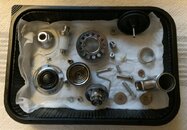Thank you for providing that link to the page. I can see myself potentially doing it with a flat screw driver or similar probe for the first time but I will eventually upgrade to the Scuba Clinic tool.There's also a cheaper route, through Scuba Clinic, that was reviewed, earlier this year:
Hand Press for Poseidon Cyklon Second Stage . . .
Scuba Clinic, of Thailand, has come up with a lightweight (210 gram), comparatively inexpensive (about US 70.00) alternative to Poseidon's 1.3 kilo, multi-hundred dollar "Assembly Tool," — both aimed at simply installing a 1.5 gram “locking ring” on a Cyklon second stage. It is composed of...scubaboard.com
Some can also manage to use a flat screwdriver or dissecting probe to fit the ring. I was shamed into trying it again, a while back, successfully; but managed to bloody myself once or twice . . .
The video on the other thread showing how to use the probe to align and lock the ring was helpful as well. Reading regulator literature is one thing, but to see it or do it is another thing.
Would you happen to know if there is a full disassembly-reassembly video for the cyklon second stage?
I appreciate the all the assistance.
Erik




